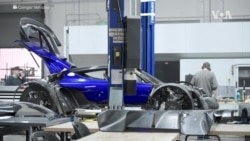((TITLE)) 3D CAR PRINTING
((TRT: 04:42))
((Reporter/Camera/Editor/Producer: Genia Dulot))
((Map: Los Angeles, California))
((Main characters: 0 female; 2 male))
((Sub characters: 0 female; 0 male))
((Blurb: Los Angeles based automaker Kevin Czinger and his son Lucas are introducing digital manufacturing, that will change how we make cars and save the environment))
((NATS))
((Lukas Czinger
Divergent 3D Co-founder))
Automotive manufacturing is 100 years old. It is very much so locked in design-specific tooling and is very much so has a large negative impact in terms of emissions produced from that manufacturing process.
((Kevin Czinger
Divergent 3D Founder))
The traditional way of making cars was just broken. It took too much time, and too much capital, and was too risky because all of that time and capital went into a set of industrial cookie-cutters that couldn’t be changed. They could only cut the same cookie, no matter what the market said, no matter what innovation came. And so I said, “Do away with a cookie-cutter and create a system that’s a full digital system. Idea in, product out. Different idea in, same system, different product out.”
((Lukas Czinger
Divergent 3D Co-founder))
We came onto this idea of, okay, we can engineer a part more efficiently, because we have computational power. We’re not making full use of it in auto today, but it exists. We can compute many variables, you know, using machine learning and AI [Artificial Intelligence] to actually optimize a perfect, efficient structure.
((Lukas Czinger
Divergent 3D Co-founder))
Look at this part for example. You know, this is one from our rear subframe for the 21C. Typically, you would cast this part. You wouldn’t 3-D print this part. This is a fully printed part. If you were casting this part, you would never have these actual geometries. You could never have these internal geometries. So in the end, you would be creating a part that is much heavier and is actually not perfectly optimized for its load cases. Not only would it be heavier, but if you want to change that part, you’d have to make a new casting mold, so re-engineer your entire casting mold just to make one design change. In our process, we just re-optimize with the software. We print it on our 3D printers in metal, perfectly optimized, wasting no material. And if you want to make a design change, within days we can have a new part to you.
((NATS))
((Kevin Czinger
Divergent 3D Founder))
So this is the most powerdense production, powertrain internal combustion engine ever designed and built. It’s designed and built by Czinger as well. It has an output of 998 horsepower with the two EV motors upfront. The total horsepower is a little under 1400 horsepower.
((Lukas Czinger
Divergent 3D Co-founder))
When you look at this engine bay, and you understand really that this is from the cross brace here, the rear frame to the exhaust system, a perfectly Prado optimized structure, meaning there’s not a single gram more material on that structure today than you need.
((Kevin Czinger
Divergent 3D Founder))
This car symbolizes the transition from a built world, like physically human built world that’s analog, to a completely new, much more efficient world, a world that’s much more in harmony with nature because it minimizes material and energy use, maximizes the efficiency of the product by making it much lighter while being just as safe and higher performing, so it uses less fuel and other resources. And all of the structures that we print are made of materials that are completely recyclable.
((Lukas Czinger
Divergent 3D Co-founder))
And then start with an application like this that is low volume, gets people’s attention, gets by and proves the tech, but then show it and evolve it into mass scale. And that’s where we ultimately want to go. We want to see the majority of vehicles, ten years from now, manufactured with this system. We want to see global CO2 levels associated with vehicle manufacturing reduced, and reduced based on this manufacturing system that we’ve invented and commercialized.
((Kevin Czinger
Divergent 3D Founder))
And then the final part is democratization. If someone no longer needs to spend money to design something, and then they’ll need to build a factory to manufacture it,
((Courtesy: Czinger Vehicles))
but they can simply have a set of tools that’ll allow them to design anywhere on the planet, and then the facility to do that is digital, and then they can just send their design and have it printed and assembled,
((end Courtesy))
then you’re democratizing the ability of people to create.
((Courtesy: Czinger Vehicles))
And so the end vision is: have a built world that’s digitized, so that it can become much more material and energy efficient. Therefore, it becomes environmentally sustainable, and then creating a permanent localized community of creation.
((end Courtesy))
People then design locally, manufacture locally, use locally, and the materials flow locally.
((Courtesy: Czinger Vehicles))
Episodes
-
![Open Water Swimming]() May 10, 2024
May 10, 2024Open Water Swimming
-
![Women Scuba Divers]() May 10, 2024
May 10, 2024Women Scuba Divers
-
![Antarctica’s Thwaites 'Doomsday' Glacier]() May 10, 2024
May 10, 2024Antarctica’s Thwaites “Doomsday” Glacier
-
![Nature | Washington Park Arboretum]() May 10, 2024
May 10, 2024Nature | Washington Park Arboretum
-
![Handbells]() May 03, 2024
May 03, 2024Handbells
-
![Fred’s Lounge, The Heart of Cajun Music]() May 03, 2024
May 03, 2024Fred’s Lounge, The Heart of Cajun Music











